2-Bromonaphthalene
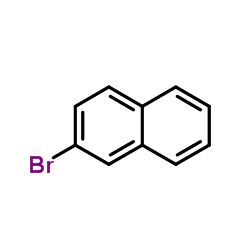
2-Bromonaphthalene structure
|
Common Name | 2-Bromonaphthalene | ||
|---|---|---|---|---|
| CAS Number | 580-13-2 | Molecular Weight | 207.067 | |
| Density | 1.5±0.1 g/cm3 | Boiling Point | 282.7±9.0 °C at 760 mmHg | |
| Molecular Formula | C10H7Br | Melting Point | 52-55 °C(lit.) | |
| MSDS | Chinese USA | Flash Point | 127.8±13.1 °C | |
| Symbol |

GHS07 |
Signal Word | Warning | |
| Name | 2-Bromonaphthalene |
|---|---|
| Synonym | More Synonyms |
| Density | 1.5±0.1 g/cm3 |
|---|---|
| Boiling Point | 282.7±9.0 °C at 760 mmHg |
| Melting Point | 52-55 °C(lit.) |
| Molecular Formula | C10H7Br |
| Molecular Weight | 207.067 |
| Flash Point | 127.8±13.1 °C |
| Exact Mass | 205.973099 |
| LogP | 4.22 |
| Vapour Pressure | 0.0±0.6 mmHg at 25°C |
| Index of Refraction | 1.663 |
| InChIKey | APSMUYYLXZULMS-UHFFFAOYSA-N |
| SMILES | Brc1ccc2ccccc2c1 |
| Storage condition | 2-8°C |
| Water Solubility | slightly soluble |
Synonym:Tert-Butyl Bromid Section 2 - COMPOSITION, INFORMATION ON INGREDIENTS
Risk Phrases: None Listed. Section 3 - HAZARDS IDENTIFICATION EMERGENCY OVERVIEW
The toxicological properties of this material have not been fully investigated. Potential Health Effects Eye: May cause eye irritation. The toxicological properties of this material have not been fully investigated. Skin: May cause skin irritation. The toxicological properties of this material have not been fully investigated. Ingestion: May cause gastrointestinal irritation with nausea, vomiting and diarrhea. The toxicological properties of this substance have not been fully investigated. Inhalation: May cause respiratory tract irritation. The toxicological properties of this substance have not been fully investigated. Chronic: No information found. Section 4 - FIRST AID MEASURES Eyes: Flush eyes with plenty of water for at least 15 minutes, occasionally lifting the upper and lower eyelids. Get medical aid immediately. Skin: Get medical aid. Flush skin with plenty of water for at least 15 minutes while removing contaminated clothing and shoes. Wash clothing before reuse. Ingestion: Never give anything by mouth to an unconscious person. Get medical aid immediately. Do NOT induce vomiting. If conscious and alert, rinse mouth and drink 2-4 cupfuls of milk or water. Inhalation: Remove from exposure and move to fresh air immediately. If not breathing, give artificial respiration. If breathing is difficult, give oxygen. Get medical aid. Notes to Physician: Section 5 - FIRE FIGHTING MEASURES General Information: As in any fire, wear a self-contained breathing apparatus in pressure-demand, MSHA/NIOSH (approved or equivalent), and full protective gear. During a fire, irritating and highly toxic gases may be generated by thermal decomposition or combustion. Vapors may be heavier than air. They can spread along the ground and collect in low or confined areas. Extinguishing Media: Use agent most appropriate to extinguish fire. Use water spray, dry chemical, carbon dioxide, or appropriate foam. Section 6 - ACCIDENTAL RELEASE MEASURES General Information: Use proper personal protective equipment as indicated in Section 8. Spills/Leaks: Clean up spills immediately, observing precautions in the Protective Equipment section. Sweep up, then place into a suitable container for disposal. Avoid generating dusty conditions. Provide ventilation. Section 7 - HANDLING and STORAGE Handling: Wash thoroughly after handling. Use with adequate ventilation. Avoid contact with eyes, skin, and clothing. Keep container tightly closed. Avoid ingestion and inhalation. Storage: Store in a tightly closed container. Store in a cool, dry, well-ventilated area away from incompatible substances. Section 8 - EXPOSURE CONTROLS, PERSONAL PROTECTION Engineering Controls: Use adequate ventilation to keep airborne concentrations low. Exposure Limits CAS# 580-13-2: Personal Protective Equipment Eyes: Wear appropriate protective eyeglasses or chemical safety goggles as described by OSHA's eye and face protection regulations in 29 CFR 1910.133 or European Standard EN166. Skin: Wear appropriate protective gloves to prevent skin exposure. Clothing: Wear appropriate protective clothing to prevent skin exposure. Respirators: Follow the OSHA respirator regulations found in 29 CFR 1910.134 or European Standard EN 149. Use a NIOSH/MSHA or European Standard EN 149 approved respirator if exposure limits are exceeded or if irritation or other symptoms are experienced. Section 9 - PHYSICAL AND CHEMICAL PROPERTIES Physical State: Crystalline powder Color: white Odor: none reported pH: Not available. Vapor Pressure: Not available. Viscosity: Not available. Boiling Point: 281 - 282 deg C Freezing/Melting Point: 52 - 55 deg C Autoignition Temperature: Not available. Flash Point: > 112 deg C (> 233.60 deg F) Explosion Limits, lower: N/A Explosion Limits, upper: N/A Decomposition Temperature: Solubility in water: slightly soluble in water Specific Gravity/Density: Molecular Formula: C10H7Br Molecular Weight: 207.07 Section 10 - STABILITY AND REACTIVITY Chemical Stability: Stable under normal temperatures and pressures. Conditions to Avoid: Incompatible materials, dust generation, excess heat. Incompatibilities with Other Materials: Oxidizing agents. Hazardous Decomposition Products: Irritating and toxic fumes and gases, bromine fumes, bromine. Hazardous Polymerization: Has not been reported. Section 11 - TOXICOLOGICAL INFORMATION RTECS#: CAS# 580-13-2 unlisted. LD50/LC50: Not available. Carcinogenicity: 2-Bromonaphthalene - Not listed by ACGIH, IARC, or NTP. Section 12 - ECOLOGICAL INFORMATION Section 13 - DISPOSAL CONSIDERATIONS Dispose of in a manner consistent with federal, state, and local regulations. Section 14 - TRANSPORT INFORMATION IATA Not regulated as a hazardous material. IMO Not regulated as a hazardous material. RID/ADR Not regulated as a hazardous material. Section 15 - REGULATORY INFORMATION European/International Regulations European Labeling in Accordance with EC Directives Hazard Symbols: Not available. Risk Phrases: Safety Phrases: S 24/25 Avoid contact with skin and eyes. S 28A After contact with skin, wash immediately with plenty of water. S 37 Wear suitable gloves. S 45 In case of accident or if you feel unwell, seek medical advice immediately (show the label where possible). WGK (Water Danger/Protection) CAS# 580-13-2: No information available. Canada CAS# 580-13-2 is listed on Canada's NDSL List. CAS# 580-13-2 is not listed on Canada's Ingredient Disclosure List. US FEDERAL TSCA CAS# 580-13-2 is listed on the TSCA inventory. SECTION 16 - ADDITIONAL INFORMATION N/A |
| Symbol |

GHS07 |
|---|---|
| Signal Word | Warning |
| Hazard Statements | H302-H319 |
| Precautionary Statements | P305 + P351 + P338 |
| Personal Protective Equipment | dust mask type N95 (US);Eyeshields;Gloves |
| Hazard Codes | Xn:Harmful; |
| Risk Phrases | R22;R36 |
| Safety Phrases | S26-S36-S45-S36/37 |
| RIDADR | UN 1230 3/PG 2 |
| WGK Germany | 3 |
| HS Code | 29036990 |
| Precursor 9 | |
|---|---|
| DownStream 10 | |
| HS Code | 2903999090 |
|---|---|
| Summary | 2903999090 halogenated derivatives of aromatic hydrocarbons VAT:17.0% Tax rebate rate:9.0% Supervision conditions:none MFN tariff:5.5% General tariff:30.0% |
|
Quantitative structure-activity relationship analysis of inhibitors of the nicotine metabolizing CYP2A6 enzyme.
J. Med. Chem. 48 , 440-9, (2005) The purpose of this study was to develop screening and in silico modeling methods to obtain accurate information on the active center of CYP2A6, a nicotine oxidizing enzyme. The inhibitory potencies o... |
|
|
Exploring QSAR and QAAR for inhibitors of cytochrome P450 2A6 and 2A5 enzymes using GFA and G/PLS techniques
Eur. J. Med. Chem. 44 , 1941-51, (2009) A series of naphthalene and non-naphthalene derivatives ( n = 42) having cytochrome P450 2A6 and 2A5 inhibitory activities, reported by Rahnasto et al., were subjected to QSAR and QAAR studies. The an... |
|
|
Notes-A Convenient Synthesis of Water-Soluble Carbodiimides. Sheehan J, et al.
J. Org. Chem. 26(7) , 2525-2528, (1961)
|
| 2-bromo-naphthalene |
| 2-Bromonaphthalene |
| EINECS 209-452-5 |
| MFCD00004051 |
| Naphthalene,2-bromo |
| 2-naphthylbromide |
| 2-Naphthyl bromide |
| β-Bromonaphthalene |
| 2-naphthyl-Br |
| Naphthalene, 2-bromo- |
| β-Naphthyl bromide |
| 2-BROMO NAPHTHALENE |
 CAS#:3857-83-8
CAS#:3857-83-8 CAS#:135-19-3
CAS#:135-19-3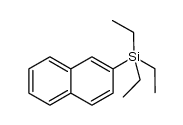 CAS#:1126479-91-1
CAS#:1126479-91-1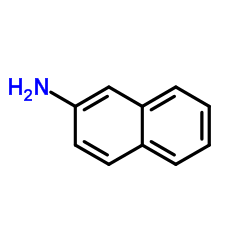 CAS#:91-59-8
CAS#:91-59-8 CAS#:256652-04-7
CAS#:256652-04-7 CAS#:95-13-6
CAS#:95-13-6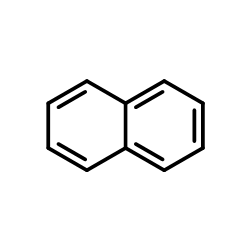 CAS#:91-20-3
CAS#:91-20-3 CAS#:1503-86-2
CAS#:1503-86-2 CAS#:2243-83-6
CAS#:2243-83-6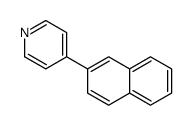 CAS#:111876-50-7
CAS#:111876-50-7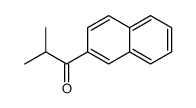 CAS#:107574-57-2
CAS#:107574-57-2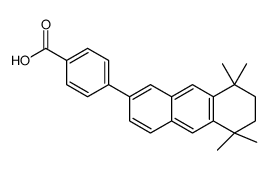 CAS#:107430-51-3
CAS#:107430-51-3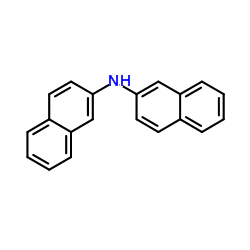 CAS#:532-18-3
CAS#:532-18-3 CAS#:59345-42-5
CAS#:59345-42-5 CAS#:32316-92-0
CAS#:32316-92-0 CAS#:323-09-1
CAS#:323-09-1 CAS#:474688-73-8
CAS#:474688-73-8 CAS#:612-55-5
CAS#:612-55-5
